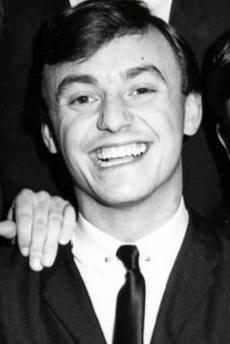The Belmonts are an American doo-wop group from the Bronx, New York, that originated in the mid-1950s. The original group consisted of Angelo D'Aleo, Carlo Mastrangelo, and Fred Milano. They took their name from Belmont, the Bronx neighborhood in which they lived, known as the Little Italy of the Bronx. There were several stages in their history, including the 1958–60 period with Dion DiMucci when the group was named Dion and the Belmonts. At this time Mastrangelo sang the bass parts, Milano the second tenor, D'Aleo the falsetto, and DiMucci did lead vocals.

Gerry’s Pacemakers, known until 2018 as Gerry and the Pacemakers, were a British beat group prominent in the 1960s Merseybeat scene. In common with the Beatles, they came from Liverpool, were managed by Brian Epstein, and were recorded by George Martin. Their early successes alongside the Beatles were instrumental in popularizing the Merseybeat sound and launching the wider British beat boom of the mid-1960s.

Dion Francis DiMucci, better known as Dion, is an American singer, songwriter and guitarist. His music incorporates elements of doo-wop, pop, rock, R&B, folk and blues. Initially the lead singer of the vocal group Dion and the Belmonts, Dion embarked on a solo career, and was one of the most prominent rock and roll performers of the pre-British Invasion era. He had 39 Top 40 hits in the late 1950s and early 1960s as a solo performer, or with the Belmonts and the Del-Satins. He is best remembered for his signature hit songs "Runaround Sue", "the Wanderer", "Ruby Baby" and "Lovers Who Wander", among others.

The Chiffons are an American girl group originating from the Bronx, a borough of New York City, in 1960.

Gerard Marsden MBE was an English singer-songwriter, musician and television personality, best known for being leader of the Merseybeat band Gerry and the Pacemakers. He was the younger brother of fellow band member Freddie Marsden.

United Artists Records was an American record label founded by Max E. Youngstein of United Artists in 1957 to issue movie soundtracks. The label expanded into other genres, such as easy listening, jazz, pop, and R&B.
"Hushabye" is a song that was written by Doc Pomus and Mort Shuman in 1959 for the Brooklyn doo-wop quintet the Mystics. The group's recording of the song was a Top 20 hit.
The Mystics are an American rock and roll group that began in Brooklyn, New York, United States, in the late 1950s. The group was known as The Overons, a quintet that, when signed to Laurie Records, consisted of Phil Cracolici, Albee Cracolici, George Galfo, Bob Ferrante, and Al Contrera. Under the direction of their manager, Jim Gribble, The Overons became The Mystics when each group member wrote a name they liked on a slip of paper and placed the papers in a hat; Contrera's choice was drawn.
The Jarmels was an American doo wop rhythm and blues group formed in 1959 in Richmond, Virginia best known for their only 1961 hit, "A Little Bit of Soap".
Ernest Peter Maresca was an American singer, songwriter and record company executive, best known for writing or co-writing some of Dion's biggest hits, including "Runaround Sue" and "The Wanderer".

"The Wanderer" is a song written by Ernie Maresca and originally recorded by Dion, released on his 1961 album Runaround Sue. The song, with a 12-bar blues-base verse and an eight-bar bridge, tells the story of a travelling man and his many loves. The song is ranked number 243 on the Rolling Stone magazine's list of The 500 Greatest Songs of All Time.

Dion and the Belmonts were an American vocal trio prominent throughout the 1950s. All of its members were from the Bronx, New York City. In 1957, Dion DiMucci joined the vocal group the Belmonts. The established trio of Angelo D'Aleo, Carlo Mastrangelo and Fred Milano formed a quartet with DiMucci.
The Del-Satins were an American vocal group, most active in the early 1960s, who recorded on their own but are best remembered for their harmonies on hit records for Dion and others. They have been described as having "few peers as practitioners of white doo-wop."
"I Wonder Why" is a doo-wop song, written by Melvin Anderson with lyrics by Ricardo Weeks. The song was first recorded by Dion and the Belmonts.
Jamie Records is a record label founded in Philadelphia, Pennsylvania, in 1956 by Harold Lipsius (1913–2007) and Allan Sussel (1924–2003). Their first 45rpm single, "It's Great to Fall in Love"/"Truly" by Marian Caruso, was issued in 1956. The label was named after Allan Sussel's eldest daughter, Jamie Sussel Turner.
"A Teenager in Love" is a song written by Doc Pomus and partner Mort Shuman. It was originally recorded by Dion and the Belmonts, and released in March 1959. It appeared on their album Presenting Dion and the Belmonts (1959). It reached number 5 on the Billboard pop charts.
Richard Louis Holler is an American songwriter, pianist, and performer, best known as the writer of the folk-pop standard "Abraham, Martin and John". The song has been recorded by numerous artists including Dion, Ray Charles, Bob Dylan, Kenny Rogers, Emmylou Harris, Andy Williams, Marvin Gaye, Whitney Houston, and Moms Mabley, among others.

"See You in September" is a song written by Sid Wayne and Sherman Edwards. It was first recorded by the Pittsburgh vocal group The Tempos. This first version peaked at #23 in the summer of 1959. The most popular take on "See You In September" was by The Happenings in 1966, which reached #3.
"I'll Be There" is a song written and originally recorded by Bobby Darin in 1960. It was first released as B-side to his single "Bill Bailey". As such it entered the Billboard charts on July 11, 1960, and reached position 79.

Carlo Mastrangelo was an American doo-wop and progressive rock singer. Born and raised in The Bronx, he lived in an apartment on the corner of 179th St. and Mapes Ave.







